Behind the Gates of Gomorrah: An Insane Situation.
 Dr. Stephen Seager’s memoir, Behind the Gates of Gomorrah: A Year with the Criminally Insane, may be the most important book published in the last ten years.
Dr. Stephen Seager’s memoir, Behind the Gates of Gomorrah: A Year with the Criminally Insane, may be the most important book published in the last ten years.Seager, a psychiatrist at Napa State (forensic) Hospital, in California, has told America two things it very much needs to know.
One: Mass shooters are primarily paranoid schizophrenics.
Two: Forensic hospitals house violent criminals, including serial killers and child molesters, and those patients are free to mingle with staffers and each other.
Therefore, forensic hospitals are the most dangerous places in this country, both to patients and staffers.
Gomorrah is also a fantastical, almost surreal book that I found hard to put down, rubbing my eyes at 3 a.m.
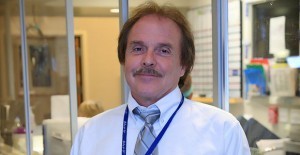
Stephen Seager
Seager has changed names to protect privacy.
Dr. Seager, thank you for the interview.
Q. You began the book with the character you called Boudreaux (who was hospitalized after walking into the place he worked and gunning down his former co-workers) cornering you and threatening to kill you, calling you a “bloodsucker.”
Then when you briefly talked to him, he snapped back to sanity. He said he had killed his closest friends, and “What kind of a man does that?”
How can the insane snap back to sanity so fast? How does it happen?
A. As it turned out later, Boudreaux suffered from what’s called a “delirium” meaning he was actually medically ill. People who suffer from delirium frequently have florid symptoms of psychosis (think of DT’s – delirium tremens) when people withdraw from alcohol.

Dr. Richard Frishman, a psychiatrist at Napa State Hospital, photographed after he was attacked by a patient.
But delirium can be caused by many things – infections, drug intoxications and withdrawal just to name a few.
Another hallmark symptom of delirium is a rapid shifting from psychosis to normal, which proved to be the case with Boudreaux.
Q. The character you call McCoy is a career criminal, who killed somebody in the hospital. You say he isn’t mentally ill. Then he threatened to kill you because you testified against him in court, to keep him in the hospital.
Is McCoy still at Napa State?
A. Yes. But testifying against your patient and then having to care for them again is a frequent occurrence, certainly not limited to McCoy and I.
Testifying against a patient is the single most dangerous thing a psychiatrist at a state hospital can do.
Q. You say all forensic hospitals are full of violence, patients against staff, and patient against patient. How did the United States put itself in this position?

Napa State staffers, in 2011, protesting violence at the hospital, following the murder of psychiatric technician Donna Gross and the beating of rehabilitation therapist George Anderson
A. During the 1960’s, a series of court decisions seriously restricting the grounds for involuntary admission to a mental hospitals coincided with President Kennedy championing the 1963 “Community Mental Health Centers Act (CMHCA)” which easily passed congress.
The CMHCA was based on the premise that if mental illness could be attacked early and in the community, that chronic mental illness could be prevented and state mental hospitals would no longer be needed.
This sweeping change was not based on a single shred of scientific evidence and, tragically, has proven to be a total disaster.
Based on the wishful thinking of the CMHCA, state mental hospitals were essentially emptied.
 The released patient’s got no better in the community – whether treated early or not – and became the homeless mentally ill that we so often see, sick and dying on the streets of American big cities today.
The released patient’s got no better in the community – whether treated early or not – and became the homeless mentally ill that we so often see, sick and dying on the streets of American big cities today.State mental hospitals with lots of empty beds (then) decided to take in “forensic” patients. Those people who had both committed crimes and were mentally ill.
Specifically to answer your question: few Americans actually care what happens to the mentally ill.
Whether these sick individuals are assaulted in state mental hospitals or whether they die on the streets, doesn’t seem to really much matter.
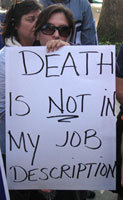
Napa State employees protesting violence at the hospital.
It’s been going on for decades: Did you know about it?
Q. Why have you stayed at Napa?
A. I stayed at Napa because my patients, who absorb most of the abuse and beatings, and the staff – mainly female nurses – really have no voice. No TV cameras, radios, newspapers, documentary film makers or anyone has ever been inside Napa State Hospital.
The BBC has tried. The New York Times has tried, 60 Minutes has tried, and they have all been stonewalled.
Forensic mental hospitals are shrouded in a conspiracy of silence.
My book gives my patients and staff at least one voice. If I had quit, my book would have been easily discounted. But since I’m still there, their voice is still there.
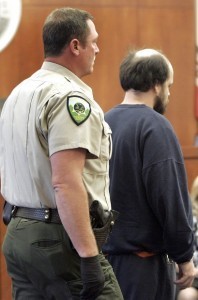
Jess Willard Massey, the Napa State Hospital patient who murdered psychiatric technician Donna Gross, is led out of Napa Superior Court following his 2011 sentencing. Massey was sentenced to 25 years to life.
Q. You say all mass shooters are (primarily) paranoid schizophrenics.
Why doesn’t everyone know about this and why hasn’t law enforcement done something about admitting all paranoid schizophrenics to a hospital?
A. Here’s some figures: 1% of the population everywhere on earth is schizophrenic so in the US that’s 3.25 million people of which maybe 1 million or so are paranoid. There are 50,000 state hospital beds nationally.
The real question is why aren’t they in mandatory out patient treatment?
People know about mass shooters and they know about mental illness but nothing is ever done, which you have noticed. If you figure out why that is, please let me know.
When I said that people don’t care about the mentally ill, I wasn’t kidding.
Q. Is the U.S. more concerned about individual rights than mass murder? Why?

Sandy Hook Elementary, Newtown, Connecticut, 2012
A. For the past fifty years, US courts have been clear that individual “liberty” interests trump pretty much everything else. Including, apparently, mass murders.
For American courts, it’s a bigger deal to force someone to take a shot once a month in the arm against their will than to gun down two dozen first grade students in an elementary school.
Q. What causes paranoid schizophrenia? Brain chemicals? Then why do all paranoid schizophrenics have the same symptoms?
A. Schizophrenia is a medical illness which has a variety of symptoms – as do most illnesses. One of the symptoms is delusions. Delusions are beliefs impervious to reason.
People who have schizophrenia and are primarily delusional are called paranoid schizophrenics.
Schizophrenia is a genetic disorder that produces abnormal brain chemistry. All disease groups have the same symptoms. Like all types of pneumonia pretty much produce fever and cough.
All paranoid schizophrenics have paranoid delusions by definition.
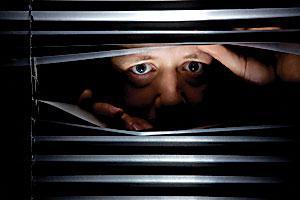
Q. As you noted in the book, many psychologists and psychiatrists do not believe in psychiatric drugs. They deny there’s evidence chemicals in the brain cause mental illness (and some deny there’s any such thing as mental illness).
Yet you believe in their effectiveness?
A. There is no serious debate about the efficacy of modern psychiatric drugs. There are remnant groups – left over from the days of Freudian analysis and the “Anti-Psychiatry Movement” of the 1960’s – who still infect mental health policy, unfortunately at some of the higher government levels.
If I stated that there was any serious doubt about psychiatric medications among the vast majority of psychiatrists and psychologists practicing today, I have given the wrong impression. There are a few well-placed hold outs, but they will pass.
Q. You began one chapter quoting a story in the Bible regarding possession. Do you believe such a thing exists?

Courtyard at Napa State
A. No. But I come from a religious background. I was born in Utah. I am a seventh generation descendant of Mormon pioneers, so I understand that many people do believe this and that’s okay.
What’s not okay is when people try to “exorcise” the demons from the mentally ill or see mental illness as “sin” – as was common in Medieval times.
People once thought pretty much all disease was caused by demons or was sent as a punishment from God.
Unfortunately, this stain tends to linger on the mentally ill, along with many other myths.

Q. You say it’s easy to forget any particular patient is a mass murderer or child molester, and some of your closest friends are mass murderers. Can you tell us more about that?
A. As a physician, you have a natural affinity for the patients entrusted to your care. You can’t help it. My patients and I are locked in together all day almost everyday. I like a lot of them. A lot of them are murderers.
It makes me uncomfortable when I think about it, but that’s the way it is.
 Q. You said a majority of doctors who work in America’s forensic hospitals are foreigners. How do they do at places like Napa? Do they experience it any differently?
Q. You said a majority of doctors who work in America’s forensic hospitals are foreigners. How do they do at places like Napa? Do they experience it any differently?A. I’m not exactly certain how they experience it but they get traumatized by all the violence just like everyone else.
The reason foreign doctors are over represented at state mental hospitals is because most American doctors won’t do it. It’s the same reason inner city clinics are populated by international physicians as well.
Americans don’t care about the mentally ill, so we have out-sourced their care.
Q. You repeatedly talk about the violence (including the doctor who was murdered and the attempted rapes and assaults). How many acts of serious violence have occurred at Napa since you began working there?
A. Hospital administration will admit to 3,000 assaults per year on patients and staff. I think the number is probably higher. I’ve been at Napa for four years so that’s 12,000 assaults.
Q. The character you called McCoy has “Hell” tattooed on his forehead. That seems about right. Can you tell us more about this?
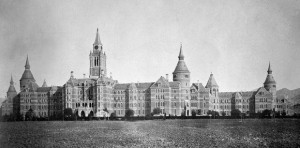
One of the first buildings at Napa State, since demolished.
A. You picked up on the same theme as The New York Times. They entitled my Nov 11th Op/Ed piece,”When Hell is the Other Patients.”
One of the first things a veteran nurse called Napa when I first began working there was, “Thunderdome,” which is about right.
HYPERLINK “https://mail.google.com/mail/u/0/h/t5...” – Show quoted text -
The post Behind the Gates of Gomorrah: An Insane Situation. appeared first on .



